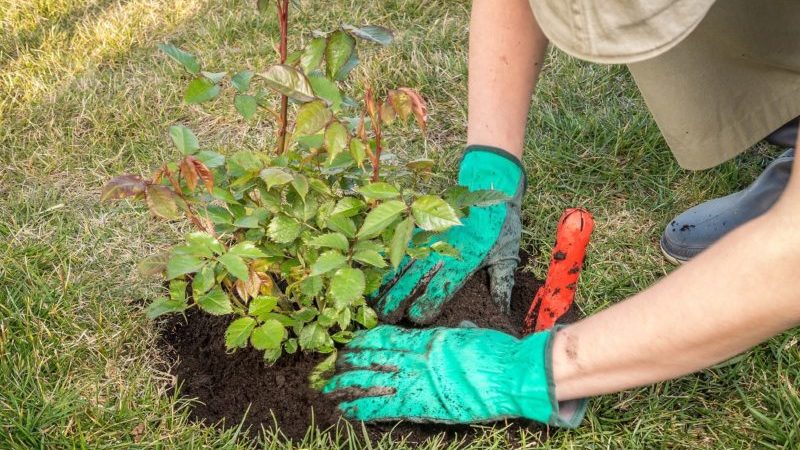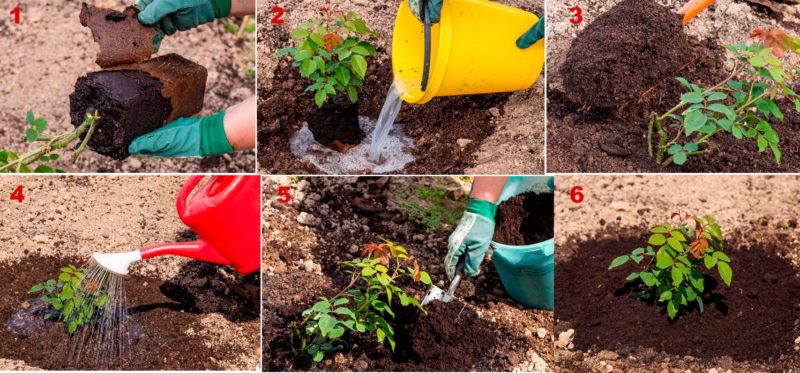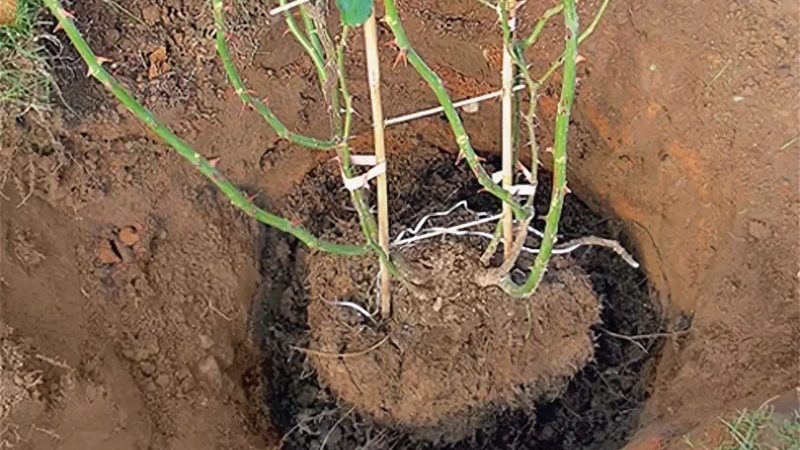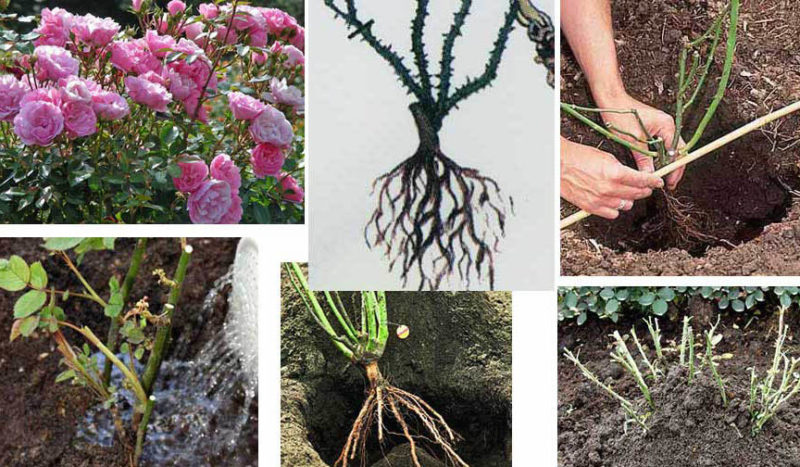Finding out if it is possible to replant roses in August and learn to do it correctly
Roses are capricious, require attention and careful care. This is the only way to get a lush and beautiful flowering. Often the initial planting site is chosen incorrectly, and the plant needs a transplant. Consider whether it is possible to replant roses in August and what to look for when choosing a new place for a rose garden.
The content of the article
Transplant timing
A favorable time for transferring rose bushes to a new place is early spring and autumn (from the second half of August to mid-September)... It is not recommended to postpone the transplant until late autumn, since a poorly rooted plant will not survive the winter.

Pros and cons of transplanting in August
The main advantage of transplanting in August is that by this time the shoots have already matured, and the growth phase has ended. Therefore, after transplanting, the plant directs all its forces to rooting and development of the root system. When the bush is transferred in the spring, the buds that wake up take the main food for themselves - the plant is depleted, since the roots have not yet taken root.
Other benefits of moving rose bushes to a new location in August:
- optimal air humidity (70–80%, which is 10–20% more than in spring) - high humidity contributes to the rapid survival of plants;
- reduction in watering - due to the large amount of rainfall, roses will not have to be moistened so often;
- warmed soil - soil temperature above + 14 ° С has a good effect on the survival rate of plants in a new place.
On the other hand, when grown in Siberia and the northern regions, cold weather sets in quickly, and even when transplanted at the end of summer, the plant may not have enough time for rooting... In this case, the procedure is carried out in the spring.
Reference. There are varieties of roses that are planted and transferred to a new place only in the spring (for example, the Black Prince or Floribunda).
The climatic conditions of the region and the specific variety of culture will help to determine when it is possible to transplant a rose from one place to another.
Auspicious days according to the lunar calendar
For those who are used to checking the moon when doing work in the garden and garden, here are favorable days for planting and transplanting roses in 2020:
- April 7;
- May 4-5, 20-21, 23-24, May 29-31;
- 1-2, 7-8, 26-29 June;
- 4, 14-15, 23-26, 31 July;
- 1-2, 10-11, 20-22, 28-29 August;
- September 5–8, 13–16.
Reasons for transplant
In the following cases, plant transplantation is mandatory. If absolutely necessary, this is done even in June and July:
- Unsuitable composition and acidity of the soil. Roses do not like loose sandy loam and heavy loamy soils. Unsuitable soil leads to squeezing of the root system to the surface, which provokes the death of the plant.
- Poor soil. The soil in the rose garden is gradually depleted, so it is transferred to a new place every few years. If this is not done, flowering will be poor.
- Overgrown bushes. Too large bushes will lack nutrition and light, which will affect the splendor of the flowering and the general well-being of the plant. In this case, the bush is cut, divided and planted in a new place.
It is interesting:
How to care for a home potted rose - a beginner's guide
A guide to cutting roses in the fall at home for beginner florists
Simple ways to save rose cuttings until spring and plant them correctly
Preparing for transplant
Competent preparation for a transplant is the key to the survival of a capricious beauty. Preparations begin by choosing a new place for the rose garden and arranging planting pits.
Seat selection
Before starting to dig up a bush, they are determined with a suitable place for a rose. The plant loves warmth and sunlight. Although many varieties grow successfully in partial shade, flowering will be less lush in this case.
Attention!A rose garden is not arranged between shrubs, shrubs and trees, since the plants will experience a lack of sunlight, which will affect their flowering and general well-being.
The best place is a large open space on the south side, without obstacles to the morning sun. The culture loves loamy fertile soils without stagnant water. If the site is located in a lowland, create a high bed.
Roses do not like dry places - in this case, they will have to be watered often. The same applies to dry sandy areas: the introduction of peat and clay under the rose helps.
Planting pit preparation
Before transplanting the rose garden (at least 3 weeks), they begin to arrange the planting pits. The size of the hole depends on the variety and size of the bush. For miniature plants, pits 30–40 cm in diameter and the same depth are prepared, for medium ones - 50–60 cm in diameter and at least 50 cm deep, for large ones - up to 1 m in diameter and 70–80 cm in depth.
Important! A hole is dug taking into account the growth of roots, it is filled with fertile soil. An insufficient hole size will adversely affect the growth and flowering of the rose: the bushes will be short, the shoots will be thin, and the flowers will be small.
Drainage is poured at the bottom of the finished pit, which will protect the rose from excess moisture. To do this, use any water-permeable, but not soaking and decaying coarse-grained material, for example, vermiculite, perlite, expanded clay medium (for large plants) and fine fraction.
Fertile soil mixed with compost is poured over the drainage layer. Rotted manure, vermicompost, bird droppings or other organic matter are added. If you plant plants in spring or early summer, you won't be able to overfeed them. When planting in the second half of summer, nitrogen fertilizers are not added, since they provoke an active growth of green mass, and this is useless before cold snaps.
It is advisable to pour 0.5 liters of ash into the top layer: it contains a lot of potassium and other trace elements loved by roses.
Transplant instructions

How to properly transplant a rose to a new location in late summer or early autumn? Immediately before the procedure, the shoots are cut off by about 20 cm, all damaged and weak shoots are removed.
The transplant itself is carried out in several stages:
- From 5 to 10 liters of water is poured onto the bottom of the pit (depending on its size). During planting, the soil should be loose and well moistened.
- The dug out bush or part of it is installed in a hole so that the neck is at ground level. If the rose was grafted, for example, on a rose hip, the neck is slightly deepened.
- The roots are evenly distributed, sprinkled with a previously prepared fertile mixture and gently tamped as they are buried.
The transplanted rose is watered and, if necessary, shaded from direct sunlight.
Transplanting a large bush

Moving a large bush is not easy. First, a trench is dug along the projection of the crown and, gradually deepening it, an earthen lump is removed. Roses are capricious, so they are transplanted with a large earthy clod.
Advice! To extract the bush along with the earthen lump, water it abundantly 1-2 days before digging it up. To make it easier to work with him and not to prick on the thorns, the ground part is wrapped with twine and put on a bag or wrapped in a dense cloth.
So that the earth does not crumble from the roots, the lump is wrapped with a cloth or plastic wrap.Long roots that interfere with the extraction of the lump are carefully chopped up with a sharp shovel. Places of cuts are dipped in charcoal before planting.
The extracted bush is placed on a wheelbarrow or spread cloth and dragged to the planting site. If the rose is moved to another area, the earthen lump is moistened and wrapped in wet burlap.
Transplanting an old rose
Rose bushes that have been growing in one place for more than 10-15 years need replanting and updating. Rejuvenation is carried out in spring or early August.
Before you start digging, the old bush is pruned, shortening all the stems to 15–25 cm from the root collar. All dry, diseased and thin shoots are completely removed. All small and large branches growing inside the bush are cut off.
Then they clean the root collar: for years, dry hemp from old stems accumulated around it. They are cut or sawed off, leaving only healthy shoots with two or more buds.
Attention! Re-transplanting or dividing the bush is carried out no earlier than 3-4 years later, since adult plants hardly take root in a new place.
Then the root system is put in order. Dry roots with signs of disease are cut out, long roots are shortened to 20–25 cm. A clay mash is prepared from water, clay and compost or rotted cow dung with "Heteroauxin" or "Kornevin". The roots and root collar are dipped in the mixture. The prepared bush is planted in a new place.
Transplant during flowering

If you want to transplant a rose during flowering, this year you will have to sacrifice beauty and remove all flowers and buds from the plant.... This helps the rose quickly take root in a new place and direct all its efforts to restore the root system, and not bloom.
With such a transplant, they are especially careful about the roots, trying to injure them as little as possible. Otherwise, the flower is transferred to a new place according to the standard scheme.
Transplanting a climbing rose
When moving to a new place of climbing varieties, digging begins with removing the shoots from the support. In ramblers, all the shoots of the current year are retained, and at the end of August (if the transplant is carried out in spring), the tops are pinched so that the branches become lignified. Shoots older than 2 years are completely removed immediately after flowering.
When moving the claimings, all long shoots are shortened by 1/2 or 1/3, otherwise it is difficult to transport the bush to a new place.
Moving a rose with dividing a bush
If you want to divide a bush, it is cut with a knife, pruner or saw into pieces. Developed roots and one or more shoots are left on each. The processes are shortened by 2/3, and the wounds formed during excavation and division are cleaned with a knife and powdered with crushed charcoal.
After planting, the bushes are abundantly watered and covered with damp earth to protect the shoots from drying out by the sun and wind.
Nuances for different growing regions
Experienced flower growers, when determining the timing of replanting roses, recommend focusing on the climatic conditions of the region. If the winters are harsh, it is more practical to move the rose garden in the spring months, as the transplant damages the roots and the bush may not have time to take root before frost.
If the climate is mild, transplanting in late summer or early autumn is preferable. The time is chosen so that at least 2-3 weeks remain before the arrival of a stable cold snap.
Common mistakes

We list the common mistakes that beginner growers make when transplanting roses:
- Change to a new location in June or July. The hot summer months are the least favorable for transplanting any crops, not just rose bushes. It is better to do this in spring or at the end of summer, then the plants will undergo the procedure less painfully.
- Preparation of insufficiently large planting holes. This error leads to unpleasant consequences if roses are grown on poor or inappropriate soils.
- Choosing the wrong place.The rose garden should not be broken in shady places or where water accumulates. Lush flowering in this case will not be.
- Inadequate care after transplant. The first weeks after moving to a new place, the bush is given increased attention: they make sure that the soil is constantly moist, shade the plant from the sun, and protect it from the cold. Otherwise, the rose will hurt and take root for a long time.
Further care
In the first month after transplanting, the bushes require constant attention. They are regularly but moderately watered, shaded from the bright midday sun, and if necessary protected from the cold. If August is hot, the crown is sprayed daily.
Roses are watered as the soil dries. Young seedlings with an unformed root system are especially dependent on moisture. With insufficient watering, the shoots stop growing, the flowers become smaller, the leaves crumble.
For irrigation, it is better to choose the evening time, when less moisture is lost during evaporation. Climbing rose varieties especially require a lot of water. After watering or rain, the soil is loosened about 5 cm deep to provide air access to the roots. It is important to timely remove weeds that take up nutrients, carry pests and pathogens.
Advice! Mulching the soil allows you to reduce the number of watering. It provides additional nutrition, improves soil structure, prevents water evaporation, and inhibits the growth of weeds. Roses are mulched with chopped straw, rotted manure, humus, compost. The bark of trees or nutshells as mulch will also decorate the rose garden.
After being transferred to a new place, roses do not disturb for several years. This is especially true for adult bushes that react painfully to transplantation.
Tips from experienced florists
Those who have long been involved in growing roses know how difficult it is to achieve abundant flowering of bushes throughout the summer.... Roses require careful grooming from spring to autumn.
In order for the plants to delight with large fragrant flowers all summer, they are regularly watered, treated for diseases in a timely manner, they fight pests, loosen the ground, remove dried, weak and diseased shoots, bring in ash and organic matter.
Plentiful watering is carried out before fertilizing. Cut off shoots and buds with a sharp secateurs, having previously disinfected it. They work with gloves so as not to scratch the skin and damage the bush.
In September, rose bushes are fed with fertilizers containing potassium. For the winter, around large bushes, they construct insulating structures made of cardboard, boxes and other improvised materials so that the plant does not freeze and the branches do not break under the weight of the snow.
Conclusion
Rose bushes periodically need replanting. At the same time, special attention is paid to choosing a new site, preparing planting holes and carefully digging out bushes. Subject to all conditions, the plant will perfectly take root in a new place and will delight with abundant flowering.
It is important to observe the timing of the transplant: spring or late summer - early autumn. If you are late with the procedure in the fall, the rose will not endure the winter well and may die.